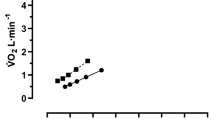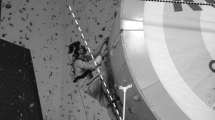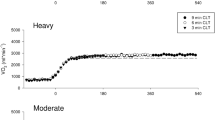Abstract
The energy cost of internal work and its relationships with lower limb mass and pedalling frequency were studied in four male subjects [age 22.2 (SD 1.5) years, body mass 81.0 (SD 5.1) kg, maximal O2 uptake (\(\dot VO_{2\max } \)) above resting 3.06 (SD 0.4) l · min−1]. The subjects cycled at 40, 60, 80 and 100 rpm and at five different exercise intensities for every pedalling frequency (unloaded condition, UL); the same exercises were repeated after having increased the lower limbs' masses by 40% (loaded condition, L). The exercise intensities were chosen so that the oxygen consumption (\(\dot VO_2 \)) did not exceed 75% of\(\dot VO_{2\max } \). For all the subjects and all the conditions, the rate of\(\dot VO_2 \) above resting increased linearly with the mechanical power (\(\dot W\)). They-intercepts of the linear regressions of\(\dot VO_2 \) on\(\dot W\), normalised per kilogram of overall lower limbs' mass were the same in both UL and L and increased with the 4.165 power of pedalling frequency (f p). These intercepts were taken to represent the metabolic counterpart of the internal power dissipation in cycling; they amounted to 0.78, 0.34, 3.29 and 10.30 W · kg−1 for pedalling frequencies of 40, 60, 80 and 100 rpm respectively. The slope of the regression lines (\(\Delta \dot W/\Delta \dot VO_2 \)) represents the Δ efficiency of cycle ergo this was also affected byf p, ranging, on average; from 22.9% to 32.0%. These data allowed us to obtain a comprehensive description of the effects off p (per minute), exercise intensity (\(\dot W\), watts) and lower limbs' mass with or without added loads (m L, kg), on\(\dot VO_2 \) (ml ·min−1) during cycling:\(\dot VO_2 \) = [m L · (4.3 · 10−8.f 4.165p /0.35)] + {1/[(3.594 · 10−5 ·f 2p − 0.003 ·f p + 0.326) · 0.35]} ·\(\dot W\). The mean percentage error between the\(\dot VO_2 \) predicted from this equation and the actual value was 12.6%. This equation showed that the fraction of the overall\(\dot VO_2 \) due to internal work, for a normal 70-kg subject pedalling at 60 rpm and 100 W was of the order of 0.2.
Similar content being viewed by others
References
Anton-Kuchly B, Roger P, Varene P (1984) Determinants of increased energy cost of submaximal exercise in obese subjects. J Appl Physiol 56:18–23
Berry MJ, Storsteen JA, Woodard MC (1993) Effects of body mass on exercise efficiency and VO2 during steady-state cycling. Med Sci Sports Exerc 25:1031–1037
Cavagna GA, Kaneko M (1977) Work and efficiency in human locomotion. J Physiol 268:467–481
Coast JR, Welch HG (1985) Linear increase in optimal pedal rate with increased power output in cycle ergometry. Eur J Appl Physiol 53:339–342
di Prampero PE, Mognoni P, Saibene F (1979) Internal power in cycling. Experientia [Abstr] 35:925
Ericson MO (1988) Mechanical muscular power output and work during ergometer cycling at different work loads and speeds. Eur J Appl Physiol 57:382–387
Fenn WO (1930) Frictional and kinetic factors in the work of sprint running. Am J Physiol 92:583–611
Gaesser GA, Brooks GA (1975) Muscular efficiency during steadyrate exercise: effects of speed and work rate. J Appl Physiol 38:1132–1139
Kamon E, Metz KF, Pandolf KB (1973) Climbing and cycling with additional weights on the extremities. J Appl Physiol 35:367–370
Kaneko M, Yamazaki T (1978) Internal mechanical work due to velocity changes of the limb in working on a bicycle ergometer. In: Asmussen E, Jurgenson K (eds) Biomechanics VI-A. University Park Press, Baltimore, Md pp 86–92
Luhtanen P, Rahkila P, Rusko H, Viitasalo JT (1987) Mechanical work and efficiency in ergometer bicycling at aerobic and anaerobic thresholds. Acta Physiol Scand 131:331–337
Wells R, Morrissey M, Hughson R (1986) Internal work and physiological responses during concentric and eccentric cycle ergometry. Eur J Appl Physiol 55:295–301
Widrick JJ, Freedson PS, Hamill J (1992) Effect of internal work on the calculation of optimal pedalling rates. Med Sci Sports Exerc 24:376–382
Winter DA (1979) Biomechanics of human movement. Wiley, New York
Author information
Authors and Affiliations
Rights and permissions
About this article
Cite this article
Francescato, M.P., Girardis, M. & di Prampero, P.E. Oxygen cost of internal work during cycling. Eur J Appl Physiol 72, 51–57 (1995). https://doi.org/10.1007/BF00964114
Accepted:
Issue Date:
DOI: https://doi.org/10.1007/BF00964114




